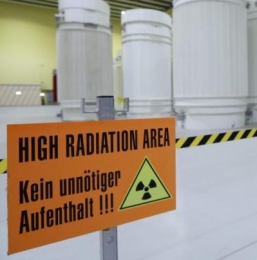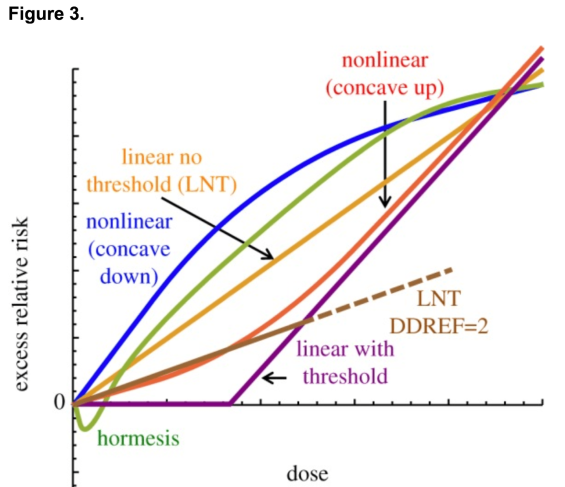 I recently visited Switzerland’s interim repository for nuclear waste, called ZWILAG, and wrote about the insights gained during that experience in Warming My Hands On Nuclear Waste. While in the heart of the place – the dry cask storage hall which houses the spent nuclear fuel – we crossed a line with a sign that read: “HIGH RADIATION AREA No unnecessary stay !!!” (photo).
I recently visited Switzerland’s interim repository for nuclear waste, called ZWILAG, and wrote about the insights gained during that experience in Warming My Hands On Nuclear Waste. While in the heart of the place – the dry cask storage hall which houses the spent nuclear fuel – we crossed a line with a sign that read: “HIGH RADIATION AREA No unnecessary stay !!!” (photo).
We were allowed into the area, and could discover for ourselves the difference to touch of older (cold) casks and the freshly brought ones (pleasantly warm). The guides vaguely said the levels of radiation in the area were not dangerous in the time-frame of our visit, or the time spent inside for the people working there, but they could not give me more specific information about limits, or about a length of duration that could be considered harmful. This left me curious. I wanted to know:
How dangerous is a “high radiation area?”
There were stationary measuring stations monitoring the levels of neutron and gamma radiation at a roughly five-meter distance from the closest casks, reporting levels of 7 µSv/h for neutrons and 21 µSv/h for gamma rays. To set the values in perspective, this is more than 100 times normal background radiation (about 0.2 µSv/h). But are they harmful?
Let’s first take a look at what kind of levels of radiation are considered normal: the global average annual dose of radiation, according to UNSCEAR, is 2.4 mSv, although large populations may routinely receive a lot more, in the range of 10-20 mSv. This is also the annual allowed limit for employees at a nuclear plant in Switzerland (20 mSv).

The residential area Pispala in Tampere. Photo by Tomisti, CC BY-SA 3.0.
In the US, the annual average is about 6.2 mSv (of which 3 mSv from medical imaging), and in Switzerland, about 4 mSv.
In Finland (where I’m from), the annual national average is 3.2 mSv (down from 2004 estimate of 3.7 mSv), but there are large local variations to this number. My family hails from near the city of Tampere, and a particularly posh area there, called Pispala (which we drive past every summer holiday), as well as the city center itself have such rich natural deposits of uranium, that indoor air measures on average at levels of 20-30 mSv per year.
Levels like these – although natural in several populated areas – when measured in the wrong context, may on the other hand create quite a bit of fear and anxiety, and be considered abnormal.
What is normal is context-dependent
Most of the inhabitants included in the Fukushima evacuation escaped an annual dose of about 4 mSv per year – a clearly larger dose than the low Japanese average, but a level that is not very particular to, say Finns or Americans. Greenpeace later also raised a ruckus about the uninhabitability of the village of Iitate, which had been declared fit for re-habitation by the authorities, with levels of indoor air of about 10 mSv per year. With the same logic many areas of Finland could be considered uninhabitable as well (read more about that in Janne Korhonen’s blog: Hey Greenpeace, could you find us Finns a warm place to live in?).

Part of the excellent radiation infographic by xkcd
But at which point are these levels actually dangerous?
Figuring out the radiation dose where an observable increase in cancer risk occurs (on a population level), is a harder question.
The general levels of ionizing radiation in the dry cask storage hall were certainly not high enough to be considered an immediate health risk. A few hour stay would net us under a hundred microsieverts worth of exposure, on par with a flight from LA to NY, or there and back (see the largest set of blue blocks in the xkcd infographic).
To get near the kind of doses of radiation which have been linked with an increased cancer risk, I would have to remain at the spot of that measuring station for at least five months straight, day and night. If I’d be allowed to go home in between, only staying during the standard working hours (say 40 hours a week), then I’d have to spend nearly two years worth of working time standing there. That’s how long it would take before I would have come up to 100 mSv – nearing the kind of doses that can be linked to an increase in risk for cancer.
The next question is: how big would that increase in risk be? From the data we have from Hiroshima bomb survivors, it is calculated that per 100,000 people exposed to a dose of 100 mSv, during their life-time we would eventually see about 1000 excess cases of cancer (on top of the baseline of about 40,000 cancers expected normally). The caveat is that this dose was accumulated by the bomb-survivers during a very short time.
Large one-time doses will carry a lot more risk than steady background accumulation, because our bodies have evolved to work and repair themselves under a certain constant level of bombardment from natural radiation.
Risks from steady background levels of radiation are hard to pin down
It turns out that the data from effects of low level radiation, especially when spread evenly over time, is very noisy (see below). Below 200 mSv (or 0.2 Sv in the graph), we see both positive and negative correlations – slightly decreased or increased life-time cancer risks. This has also given rise to the idea that low levels of radiation could actually have protective effects against cancer by activating repair-enzymes systems in our cells to a state of higher readiness. This concept is called hormesis.
To what degree such an effect could play a role, I can’t say, but it seems to be the case that in places with naturally very high background radiation (even higher than Tampere), like Kerala in India, and Ramsar in Iran, populations can live in areas with natural exposures that reach up to 40-130 mSv per year without yielding very definitive effects on rates of cancer incidence.

This graph is a section of the Figure 1 in a recent summary paper on evidence of the link between radiation and cancer: McLean et al, 2017, A restatement of the natural science evidence base concerning the health effects of low-level ionizing radiation. The potential effects below 100 mSv (or 0.1 Sv on the x axis) are very small, either reducing or increasing cancer risk slightly. The picture is similar for solid cancers and leukemia.
It is important to note, that the graph above demonstrates a common problem: when many studies with varying results exist, people who are interested in justifying a particular point of view can pick the studies that support their view and conveniently ignore the rest. Looking at the spread in the studies included in the graph, it is clear that a person motivated to find data to back up either conclusion (that low level radiation is or isn’t harmful) can find what they want.
This is why it is always vitally important to look not for a single study, or even a handful of studies which support one view, but to put the evidence in context: all studies with robust methods should be weighed together, studies with more rigorous methodology and larger sample sizes carrying more weight, and we should consider the picture that arises from the convergence of these different lines of evidence.
What we can form quite a clear idea about, is that the magnitude of the effect of doses of up to a few hundred mSv a year is quite limited.
The majority source of radiation for the public remains natural deposits in the bedrock, and radon gas accumulating in the indoor air is the largest form of risk. All in all, the statement paper from McLean et al 2017, from the Royal Proceedings summarises that:
Compared with other common health risks (obesity, tobacco smoking, ambient particulate air pollution) the number of years of life lost due to radiation exposure is small.

From Appendix A of McLean et al, 2017
Back to the dry cask hall
What does all this entail for a conclusion about the very high radiation area in the dry cask hall with nuclear waste?

While it is unclear if camping in the cask hall periodically would actually cause any harm, there might be a risk to living in its “high radiation area” permanently (the radiation levels there are about two or three times higher than the hotspots in Kerala and Ramsar).
I would have a greater chance of harm if I actually stayed right next to a new hot cask all the time – according to our tour guide, surface radiation levels of a freshly arrived cask are at about 100 times higher, around 250 µSv/h in the cask’s immediate vicinity. Ten full work weeks spent exclusively leaning onto the cask could quite probably cause a measurable increase in cancer risk (on a population level!).
UPDATE: Getting fresh ideas from a risk conference I went to, I decided to try my hand at visual demonstrations of toxicological safety limits and actual pesticide exposures. It struck me that the same kind of visualisation might work here too – using squares, much like the excellent xkcd strip featured in the beginning of this piece. Instead of a large scale infographic, I made a compact one, with concentric squares, to summarize much of what I have covered in the article. It shows the dosage range from where the cancer risks become clear and all the way down to the global average background.

For further handy quick references to the points of the graph, see the piece where I elaborate on them: Radiation Exposures at a Glance.
Radiation safety limits are set very cautiously
The lowest doses that can clearly be linked to cancer, however, have little to do with the setting of regulatory limits for radiation. Safety limits instead use the (openly) unconfirmed Linear Threshold Model (LNT), where assumptions are made extrapolating from a confirmed high-dose risk to a hypotethical low-dose risk, and health authorities act according to the ALARA or “As Low As Reasonably Achievable” -principle.
This principle dictates that if radiation exposure can be minimized, it should – striving to minimize radiation exposure much below levels that are linked to evidence of harm, and also much lower than in many areas of the world are accumulated naturally.
You can read more about these limits, LNT, and ALARA in the BBC article by an Oxford professor Wade Allison on radiation.

Presentation of the different models on effects from radiation from the paper by McLean et al, 2017, A restatement of the natural science evidence base concerning the health effects of low-level ionizing radiation.
High-level radiation is quite a local phenomenon
It is also good to remember that for an exposure to occur to any large degree, a person must be quite close to the highly radioactive source. Radiation decreases quickly as it disperses in space, and after leaving the immediate proximity of a radiation source (like the freshly filled dry cask), the diminishing levels can be calculated according to the inverse-square law – a 10 meter distance would reduce the radiation to about 1/100th, at 20 meters it would be 1/400th, and so on.

My gas mantles, ~ 15 µSv/h
At the measuring station at the door of the cask hall, the meter already reported 3 µSv/h of neutron and 10 µSv/h gamma radiation, less than a hundreth of the hot cask surface level of about 250.
These levels at the door were on par with holding onto one or two small gas mantles – kind of socks that glow when heated, and which were the sources of light in old gas lamps, readily available in stores until the 90’s when the thorium in the mantles was replaced with another material to avoid health concerns for workers involved in the manufacturing. (Big thanks to Conrad Knauer who kindly shipped a pack of gas mantles for me after he heard I was getting a Geiger counter!)
The employees of the ZWILAG have no reason for worry, in any case. We were told that their occupational exposures averaged at only 0.3 mSv per year – less than a tenth of the annual average of the general population, and almost a hundreth of the legal annual limit of 20 mSv.
What about visiting the repository? Our two-hour tour netted us a whooping 2 µSv of radiation – about as much as having an arm x-ray.
You can read more about the interesting insights gained during my visit here: Warming My Hands on Nuclear Waste, or about how I first came to reconsider my views about nuclear waste in: Nuclear Waste: Ideas vs Reality.

For more articles on nuclear power and radiation, you can find my pieces under Climate and Energy.
If you would like to have a discussion in the comments below, please take note of my Commenting policy. In a nutshell:
- Be respectful.
- Back up your claims with evidence.



Nicely written!
LikeLiked by 1 person
Phew! 😉 Thanks for letting me know!
LikeLike
Pingback: Warming My Hands on Nuclear Waste | Thoughtscapism
Well done! Communicative to the ‘general public’.
Prof Marek K. Janiak (radiobiology),
LikeLiked by 1 person
Hi I work at Indian Point nuclear power plant in New York. I have worked there for 35 years. I work out in the field as a mechanic. I have worked in high radiation areas. I do what is called power entries. That means while the plant is running. I go into vapor containment to repair plant equipment. Vapor containment is the dome that contains the reactor. When we go into the VC my TLC (that is a badge that In wear to see how much radiation I have collected. This badge has a neutron chip in it to see how much neutron radiation I have collected (At a PWR the only you collect neutron radiation is when you make a power entry) My life time dose from my working at a nuclear power plant is over 15 REM. I have never had cancer! I am 62 years old.
LikeLike
Tom is it likely one factor preventing cancer was your exposure to low doses ( even though cumulative seems large) over many years is likely a key factor to being cancer-free? I think I’m staying and asking the obvious….. just wanted to chime in, do you know any colleges who are not CF, and their carrier Criteriun?
Thanks
David Tremain
LikeLike
Pingback: Risk In Perspective: Zero Risk Is an Impossible Dream | Thoughtscapism
Pingback: Radiation Exposures at a Glance | Thoughtscapism
Pingback: Risk In Perspective: Zero Risk Is an Impossible Dream
Pingback: “What About Chernobyl?” World’s Deadliest Energy Accidents in Perspective | Thoughtscapism
Pingback: Visiting Chernobyl, Day One, The Most Dangerous Part of the Trip: Kyiv | Thoughtscapism
Pingback: Contaminated Concepts about Chernobyl | Thoughtscapism
Pingback: The Animals of Chernobyl – Trip Report, Day Three | Thoughtscapism
Pingback: The Town That Remained Despite the Chernobyl Accident | Thoughtscapism
Very thoughtful blogg
LikeLike